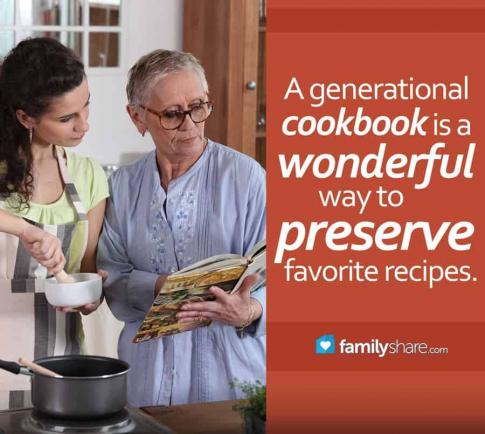
Some of your best family memories are likely tied to food. When you think back to times you've spent together with loved ones, food is often that comforting, delicious link that ties everyone together. When children grow up, they will usually want to keep some of the familiar foods they were raised with as part of their adult menus and pass them on to their own children.
So if you want the recipe for grandma's dinner rolls, and mom's pot roast, along with your own chocolate chip cookies, what do you do?
You can make a generational cookbook. With modern technology, the task is made simpler. Following are a couple of ways to go about creating a family cookbook.
Binder method
Begin by collecting recipes from everyone you'd like to include. This can be done easily through email, or for older relatives it may be best to borrow their recipe box for a short time so you can copy the recipes you want. This gathering stage can be the trickiest, but once you have everything together, you're ready to start assembling.
Some people simply photocopy the recipe card itself, or even pages torn from magazines, while others type or handwrite recipes onto special paper. Photocopying the recipe cards gives the added pleasure of seeing the recipe in the handwriting of your loved one. Re-typing will give the recipes a uniform, easy-to-read look. It's your choice.
Once you have all the recipes prepared, put them in sheet protectors and then assemble into a 3-ring binder. The sheet protectors will serve two purposes: 1) provide the 3-punch holes necessary to put them into a binder, and 2) protect the recipes from splatters and wear. To create categories within the book, purchase dividers at an office supply store.
Professionally printed method
Use the same recipe-gathering tips as for the binder method. When you have collected all your recipes, use an Internet search to select a company that can professionally print your cookbook for you.
Some printers will ask you to provide pages formatted as PDF files, which is good if you'd like to include scans of actual recipe cards or other special formats. Others printers make it very simple by providing a fill-in-the-blank form, where you type in your recipe information in the appropriate fields - the printer then does the rest, including categorizing the recipes and creating an index. Some companies will even help with the gathering stage. You give them email addresses of your family members, and they send each person an invitation to submit their recipes online.
Some companies allow more custom formatting. For example, they may categorize recipes by generation or person instead of food type, and allow you to insert photos, which is a wonderful way to personalize your cookbook and make it a treasure of its own.
While using a professional printer to prepare your recipe book may cost more than doing it yourself using the binder method, it makes it much easier and more efficient to make multiple copies for other family members.
So whether you use a binder you've prepared yourself or a professional service to create your book, a generational cookbook is a wonderful way to preserve favorite recipes for years to come. Don't wait too long - capture those delicious recipes before they fade into nothing but a warm memory. This week, decide which method you will use to create the cookbook, then either begin gathering supplies for your binders, or do the research online to decide on a professional company you will use to print the books.

